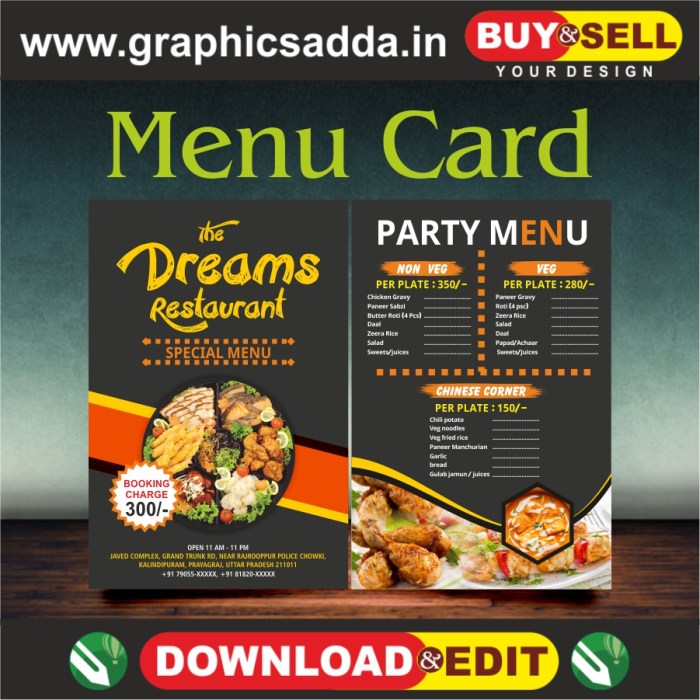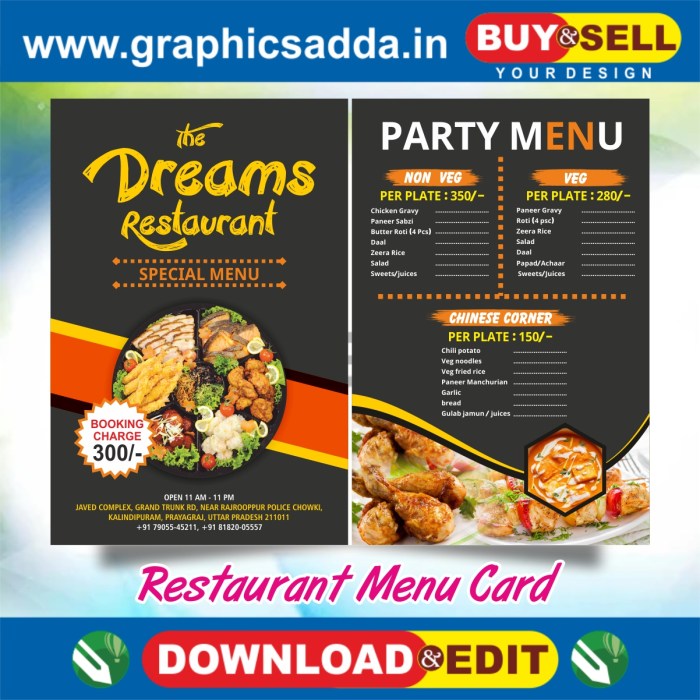Crafting an Impressive Menu Card Design: Elevating the Dining Experience
With menu card design at the forefront, this paragraph opens a window to an amazing start and intrigue, inviting readers to embark on a storytelling journey filled with unexpected twists and insights.
Delving into the world of menu card design unveils a realm where creativity meets functionality, transforming a simple piece of paper into a powerful tool that shapes the culinary adventure of diners. From the careful selection of fonts and colors to the strategic placement of images, every detail plays a vital role in capturing attention and guiding choices.
Let's explore the art of menu card design and unravel its secrets together.
Importance of Menu Card Design

Menu card design plays a crucial role in the overall dining experience at a restaurant. It is not just a list of dishes; it is a reflection of the restaurant's identity, style, and attention to detail.
A well-designed menu card can enhance the dining experience in several ways. Firstly, it can set the tone for the meal, creating anticipation and excitement among the customers. Secondly, it can help customers navigate through the offerings more easily, making the decision-making process smoother and more enjoyable.
Lastly, a visually appealing menu card can leave a lasting impression on the customers, making them more likely to remember and recommend the restaurant.
Impact of Menu Card Layout
The layout of a menu card is crucial in shaping customer perception and influencing their decision-making process. Here are some ways in which menu card layout can impact the overall dining experience:
- Organization: A well-organized menu card can help customers quickly find what they are looking for, leading to a more satisfying dining experience.
- Visual Hierarchy: The use of fonts, colors, and images can guide customers' attention towards certain items, influencing their choices and increasing sales of specific dishes.
- Descriptions: Clear and enticing descriptions can make the dishes more appealing, encouraging customers to try new items and explore the menu further.
- Pricing Placement: Strategic placement of prices can influence customers' perception of value and help them make informed decisions based on their budget.
Elements of an Effective Menu Card
When designing a menu card, there are several key elements that should be carefully considered to ensure its effectiveness in capturing the attention of customers and guiding their dining choices. Typography, color scheme, and imagery play a crucial role in creating a visually appealing and informative menu card.
Striking a balance between aesthetics and readability is essential to make the menu card both attractive and easy to navigate for customers.
Typography
The choice of typography on a menu card can significantly impact the overall look and feel of the design. It is important to select fonts that are easy to read, especially for the menu items and descriptions. Using a combination of fonts for headings, subheadings, and body text can help create hierarchy and improve the organization of information on the menu card.
Additionally, ensuring proper spacing between lines and paragraphs can enhance readability and make the menu card more visually appealing.
Color Scheme
The color scheme of a menu card can evoke emotions and set the tone for the dining experience. It is essential to select colors that complement the overall theme of the restaurant and reflect the brand identity. Using contrasting colors for different sections of the menu can help differentiate categories of items and guide customers through the menu card.
Additionally, incorporating colors that stimulate appetite, such as warm tones like red and orange, can influence customers' food choices and enhance their dining experience.
Imagery
Incorporating imagery on a menu card can help showcase the dishes and entice customers to try new items. High-quality photos or illustrations of menu items can give customers a visual representation of what to expect, making the ordering process more engaging.
It is important to ensure that the imagery aligns with the overall aesthetic of the menu card and complements the design. Including images strategically throughout the menu card can break up text-heavy sections and make the menu more visually appealing.
Balance between Aesthetics and Readability
Achieving a balance between aesthetics and readability is crucial in designing an effective menu card. While it is essential to make the menu visually appealing with attractive typography, colors, and imagery, it is equally important to prioritize readability to ensure customers can easily navigate the menu and make informed choices.
Striking a balance between aesthetics and readability involves creating a visually engaging design that also conveys information clearly and effectively. By carefully considering the typography, color scheme, and imagery, while maintaining readability, a menu card can effectively communicate the offerings of the restaurant and enhance the overall dining experience for customers.
Types of Menu Card Designs
When it comes to menu card designs, there are various styles to choose from depending on the theme and vibe of the restaurant. Let's explore different types of menu card designs such as classic, modern, minimalist, and more.
Classic Menu Card Design
Classic menu card designs often feature elegant fonts, ornate borders, and traditional layouts. These designs are timeless and evoke a sense of sophistication
Modern Menu Card Design
Modern menu card designs are characterized by sleek fonts, bold colors, and clean lines. These designs are often minimalist and focus on highlighting the dishes with eye-catching visuals. Restaurants like Nobu and Alinea are known for their modern menu card layouts.
Minimalist Menu Card Design
Minimalist menu card designs are simple, clean, and uncluttered. They typically feature a lot of white space, limited text, and a focus on typography. Restaurants like Noma and Eleven Madison Park are renowned for their minimalist menu designs.
Digital vs. Printed Menu Cards
Digital menu designs have become increasingly popular, especially in the era of technology. They offer interactive features, easy updates, and the ability to showcase images and videos. On the other hand, traditional printed menu cards have a tactile appeal and can create a sense of nostalgia.
Some restaurants opt for a combination of both digital and printed menus to cater to different preferences.
Tips for Creating an Engaging Menu Card
When designing a menu card, it's essential to consider how to organize menu items effectively, the importance of using high-quality images of food, and how to highlight specials, promotions, or seasonal items to capture the attention of your customers.
Organizing Menu Items Effectively
- Group similar items together, such as appetizers, entrees, and desserts, to make it easier for customers to navigate the menu.
- Use clear headings and subheadings to organize different sections of the menu for better readability.
- Consider using symbols or icons to indicate vegetarian, gluten-free, or spicy options for customers with dietary preferences.
Importance of Using High-Quality Images
High-quality images of food can significantly impact a customer's decision-making process when choosing a dish. It's essential to showcase visually appealing photos of your menu items to entice customers and create a mouthwatering experience.
Highlighting Specials, Promotions, or Seasonal Items
- Use eye-catching fonts or colors to draw attention to specials, promotions, or seasonal items on the menu card.
- Consider placing these items in a separate section or using call-out boxes to make them stand out from the rest of the menu.
- Include brief descriptions or enticing words to create excitement and encourage customers to try these featured items.
End of Discussion

As we conclude this exploration of menu card design, it becomes evident that a well-crafted menu card is more than just a list of dishes – it is a reflection of the restaurant's identity, an ambassador of its culinary offerings, and a silent yet persuasive storyteller that influences diners' decisions.
By mastering the art of menu card design, establishments can elevate the dining experience, leaving a lasting impression on guests and setting the stage for unforgettable culinary journeys.
Helpful Answers
Why is menu card design important?
Menu card design is crucial for a restaurant as it serves as the first point of contact between the diner and the culinary offerings. A well-designed menu card can attract attention, convey the restaurant's personality, and influence customer choices.
How can menu card layout impact customer perception?
The layout of a menu card can affect how customers perceive the restaurant. A cluttered design may overwhelm diners, while a well-organized layout can enhance readability and guide decision-making, creating a positive dining experience.
What are some key elements of an effective menu card design?
Key elements include typography, color scheme, imagery, and layout. These elements work together to create a visually appealing and informative menu card that entices diners and showcases the restaurant's offerings.
How can menu items be effectively organized on a card?
Organizing menu items in categories, using clear headings, and highlighting specials can help diners navigate the menu easily. Creating a logical flow of items based on courses or themes enhances the overall dining experience.
What is the significance of using high-quality images of food on a menu?
High-quality food images can stimulate appetite, evoke cravings, and visually communicate the essence of dishes to diners. Including enticing images can enhance the visual appeal of the menu card and influence ordering decisions.




